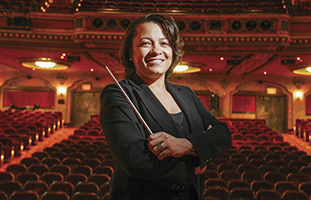The Arts as a School Motivator
October 01, 2021
How Richmond is using arts integration to revive an ailing school and infuse enthusiastic learning elsewhere

as conductor of the Richmond Symphony String Sinfonietta. PHOTO COURTESY OF RICHMOND SYMPHONY
It is not an exaggeration to say that the arts changed my life and made me who I am today: a leader in K-12 arts education for the Richmond Public Schools in Virginia where I helped transform an ailing middle school targeted for closure due to declining
enrollment. It was an initiative I could give my heart to because I found my place in school through the arts.
I knew early on as a student in Bellevue Elementary School that I was not performing as well as my friends academically. My report
cards always said “She has potential.”
Not until 6th grade, did I hear an enthusiastic comment from an educator about my ability. My orchestra teacher told me I was “great” at playing the violin. That, for me, became
the reason I woke up each day to go to school, one of those students who come to school to play their instrument, sing in the choir and participate in dance class or audition for a part in the school play. Orchestra class was my motivator.
My orchestra teacher at John Marshall High School, Thomas Shaw, recognized my academic struggles and helped me make connections to those core concepts in math, science, history and language arts through my music. He pushed me to write music and
poetry, to study the historical nature of the compositions and to create complex math problems using musical notes. I began to recognize the connections between the subjects, making it exciting to come to school each day. I realized how easy it was
to learn the core subjects once I found the links with music. School was my place to learn, explore, connect and create.
This Content is Exclusive to Members
AASA Member? Login to Access the Full Resource
Not a Member? Join Now | Learn More About Membership
About the Author
Christie-Jo Carter Adams is coordinator of K-12 arts education for Richmond Public Schools in Richmond, Va.
Generating Outside Support for School Arts
Community support is essential to the success of our arts education programs. As a central-office administrator for Richmond Public Schools, I have
some advice for those seeking partnerships.
Choose your partners well. The community arts partner’s mission and vision must be aligned to that of the school division to succeed. When the mission and vision do not match, you risk having
organizations in your schools that are not invested in what you want for your students.
After considering the fit, schedule your first meetings with those that are aligned with the district. However, do not ignore or dismiss those community
arts programs that do not initially align. It is beneficial to talk with them, as they may be interested in supporting the program but not know how to move forward.
Three questions I ask whenever considering new partnerships or assessing current
ones are: (1) What are the students’ interests? (2) What is age- and academically appropriate based on the curriculum being taught in the core classes? and (3) How and why would this partnership benefit the students at this time and in this way?
For answers, we look at student surveys and data from state assessments and solicit input from teachers, specialists and parents. These questions should be raised with the school administrators and a sampling of teachers.
Being flexible
in your decision is appropriate because sometimes the how and why come down to students simply enjoying the arts. It is not always a data-driven decision during the partnership match.
Expertise and Funding
Partnerships
fall into two categories: art professionals and art supporters. Professional artists visit classrooms and introduce students to skills and techniques and careers in the industry. Each year we have artists in residence in several of our K-12 schools. These
artists will spend anywhere from one week to six-plus weeks in our classrooms. Besides demonstrating artistic technique and skills, artists explore audition preparation and portfolio building and collaborate with teachers on lessons. Students are keenly
motivated by learning from professional artists.
Long-term arts partners also are an essential piece of our district mission. They support the district in many ways. Some partners collect supplies for students in need, while others distribute
free concert tickets to families; conduct student art contests with rewards for winning students and teachers; provide free access to art, theatre and dance classes; and donate new and gently used instruments. Other partners manage professional learning
for teachers, assist with student exhibitions and raise funds.
Successful partnerships require ongoing communication, so I meet regularly with them and assist with logistics at the schools.
We are fortunate to have worked with the
Richmond Symphony for more than 20 years, and over time our relationship expanded. It all started when we approached them with an ask of support for the purchase of new stringed instruments because of the rapid growth of our orchestra program. The single
request flourished into an annual community event where students perform as opening acts at concerts. In recent years, the symphony fund raiser committed nearly $400,000 to the district’s fine arts department. We’ve used this money for instrument
purchases, quality dance flooring and art kilns.
As with any partnership with your schools and with students, district-level leadership ought to take an active role in the program development, assessment, budgeting and curriculum. This is helpful
when initiating talks with potential partners and expanding existing partnerships in the district.
Advertisement
Advertisement
Advertisement
Advertisement



